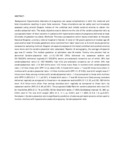| dc.description.abstract | Background: Hypertensive disorders of pregnancy can cause complications in both the maternal and fetal circulations resulting in poor fetal outcome. These circulations can be safely and non-invasively assessed using arterial Doppler indices of the umbilical and middle cerebral arteries to obtain the cerebro-placental ratio. The study objective was to determine the role of the cerebro-placental ratio as a prognostic factor of fetal outcome in patients with hypertensive states of pregnancy delivered at least 32 weeks of gestation by dates.
Methods: This was a prospective cohort study undertaken at Kenyatta National Hospital, a tertiary referral hospital in Nairobi. A total of 160 gravid patients of median age 28 years and at least 32 weeks gestations were recruited from labor ward over a 9 month study period by consecutive sampling method. Doppler ultrasound analyses of the foetal umbilical and cerebral arteries were done and the cerebro-placental ratio calculated.
Results: At sonography, the average ultrasound age was 31 weeks. The median gestation at admission was 34 weeks. Twenty nine percent had an abnormal Cerebro-placental ratio (<1.0).125/160 (78%) delivered via caesarean section and 35/160(22%) delivered vaginally.51/160(32%) severe pre-eclamptic toxaemia out of which 39% had cerebroplacental ratio<1.0 109/160(68%) had mild pre-eclamptic toxaemia out of which 24% had cerebroplacental ratio <1.0 Still births were 12.5 times more likely in mothers with cerebroplacental ratio <1.0 than those with CPR 1.0 (p value 0.05). A foetal birth score < 7 was 66 times more often in mothers with cerebro-placental ratio< 1.0 than mothers with CPR 1.0. (P 0.05). Low birth weight was 4.7 times more likely among mothers with cerebroplacental ratio < 1.0.as compared to those with mothers with CPR1.0 (95% CI 2, 11.1; p0.001). A foetal birth score < 7 was 66 times more likely among neonates delivered vaginally as compared to those born via caesarean section(95% CI 1.3, 23; p=0.02). Still births were 14.5 times more often than among neonates born vaginally as compared to those born via caesarean section (95% CI 3, 84; p0.001). The prognostic Odds Ratio for cerebro-placental ratio was 12.5 for live births (95% CI 2, 74; p=0.005), 66 for fetal birth score <7 (95% Confidence interval 13, 340; p< 0.001) and 4.7 for low birth weight (95% CI 2, 11.1; p< 0.001) and 1.1 (95% CI 0.9, 1.4; p=0.327).
Conclusion: Cerebro-placental ratio is significantly predictive of adverse perinatal outcome when used to monitor mothers with hypertensive states of pregnancy. Cerebroplacental ratio. | en_US |

